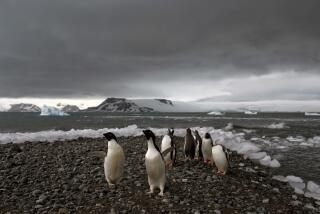Chemical Warfare a Matter of Life and Death for Antarctic Animals : Ecology: Defenseless sea butterfly, sponges and snails contain chemicals making them unpalatable to hungry predators. Researchers tell hopes for new medicines.
- Share via
McMURDO STATION, Antarctica — Life in the waters off this icy continent is anything but a dream. The only way some animals stay alive, in fact, is through bizarre manipulation of chemicals.
Some species of fish produce antifreeze 200 times more effective than what’s in a car radiator.
A small, shrimp-like animal called an amphipod carries an even smaller pteropod, a sea butterfly, clamped on its back to keep from being devoured. The kidnaped pteropod harbors chemicals unpalatable to fish.
Brightly colored sponges on the bottom of McMurdo Sound contain chemicals that make them, unlike some of their drab relatives, distasteful to sponge-eating starfish.
Otherwise defenseless nudibranchs--”naked snails”--have unique bioactive compounds in their bodies that prevent Antarctic fish and starfish from taking bites.
A yard-long Antarctic sea worm covers itself with slimy, toxic mucus that turns predators away. The substance is so acidic that it leaves marks on divers’ gloves.
Unable to flee, gaudy orange corals fill the water surrounding them with a chemical halo that scientists think broadcasts a clear message to predators: “Don’t even think about tasting me.”
Why these things happen are mysteries being explored by several teams of scientists, supported by the National Science Foundation. “It’s an interesting detective game,” said Mark H. Slattery, a graduate student in marine ecology at the University of Alabama at Birmingham.
The underwater sleuths have plenty to challenge them in the frigid, little-explored seas surrounding Antarctica.
“How can any organism stand water so cold?” asked William J. Baker of the Florida Institute of Technology.
Some of the most interesting and least publicized research is being done on creatures of the benthos, the plants and animals that live on the ocean bottom. The research holds hope for new medicines and other practical applications.
“It’s a very different habitat than anything else in the world,” said Paul K. Dayton, a marine ecologist at the Scripps Institution of Oceanography in La Jolla, Calif., who began poking around in the Antarctic ooze more than 20 years ago.
In contrast to the younger, still-developing Arctic seas, Antarctica is ancient. It broke away from the prehistoric southern megacontinent of Gondwana 40 million years ago and turned cold about 20 million years later.
“What you have is a very interesting relict population” of plants and animals that became isolated 20 million years ago,” Dayton said.
In a marriage of scientific disciplines, the co-leaders of Slattery’s research team are chemist Baker and a marine ecologist, James B. McClintock of the University of Alabama at Birmingham.
Wearing rubber “dry suits” over layers of long underwear, the scientists dive for their specimens, disappearing beneath 6-foot-thick ice for 30 minutes or less at a time.
For those rugged enough to dive in McMurdo Sound’s crystalline waters, visibility is “another order of magnitude” better than in the Bahamas, McClintock said. With the exception of a few weeks during the austral summer, a diver can see 1,000 feet in Antarctica, he said, whereas on a good day in the Bahamas visibility is about 100 feet.
The brief summer science season ended at McMurdo Station, the largest U.S. scientific and logistical base on the southernmost continent, in late February. Research continues in stateside laboratories.
McClintock and his team have known since 1989 about the sea butterfly, which flutters in abundance through the Antarctic water without so much as a nibble from hungry fish. “Clearly it’s chemically defended,” McClintock said, while its amphipod captor, if unprotected by the toxicity of the abducted mollusk, is an easy meal.
These amphipods may be Earth’s only creatures to capitalize on another species’ chemistry in this way. This year Patrick Bryan, one of McClintock’s students, identified the substance that makes the sea butterfly repugnant to fish.
Chemical defenses, often broadcast to predators by garish colors, are common in the world’s oceans. But the bright red and green Antarctic sponges are a strange study in evolutionary development.
Most waters teem with fish that see the colors and read their warning, much as birds stay away from Monarch butterflies. But Antarctica has no visually oriented predators.
What keeps starfish at arms’ length from the colored sponges is chemicals. Because the pigments themselves are bioactive, there’s no evolutionary incentive for the sponges to lose their color.
The first step in solving such chemical puzzles is to grind up organisms in an electric blender in a McMurdo laboratory, separating their components. The components are tested further in the United States.
Baker and other chemists collaborate with pharmacological and agrochemical companies in the search for practical applications of marine chemicals. One substance from a bryozoan--a moss animal--is being tested clinically as a potential anti-cancer agent.
“Organisms don’t make chemicals for no reason,” Baker said. “The bottom line is that there’s a lot of inherent bioactivity in each of the molecules that these organisms make. While the organism may have made it for the specific purpose of keeping a sea star from eating it, there may be other roles the substance can play.”
The same might be said of the natural antifreeze compounds that protect certain Antarctic fish. The peculiar proteins were discovered by Arthur L. DeVries of the University of Illinois, who has been trying to unlock their secrets for more than 30 years. He and his wife, fellow biologist Chris Cheng, are still hard at it.
Their aquarium tanks at McMurdo are filled with large Antarctic “cod”--not cod, actually, but Antarctic toothfish--and small Antarctic eelpouts. Different types of proteins keep the fish from freezing.
Commercial interests are seeking ways to use natural antifreeze in such diverse places as salmon hatcheries, operating rooms, fruit orchards and vegetable fields. “There hasn’t yet been any proven widespread application or usefulness of the antifreeze compounds,” Cheng said.
“There are many questions that haven’t been solved, and in the process of solving them you have new questions to ask,” she said. “It will be a continuing process.”






